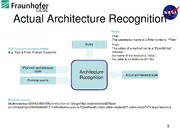
NASA Technical Reports Server (NTRS) 20100035131: Architectural Analysis of Dynamically Reconfigurable Systems PDF
Preview NASA Technical Reports Server (NTRS) 20100035131: Architectural Analysis of Dynamically Reconfigurable Systems
CESE Architectural Analysis of Dynamically Reconfigurable Systems Technical Presentation Presenter: Dharma Ganesan Principal Investigator (PI): Dr. Mikael Lindvall, CESE NASA POC: Sally Godfrey, GSFC Team members: Dr. Chris Ackermann, Dr. Arnab Ray, Lyly Yonkwa (CESE) GMSEC, CFS, RBSP In collaboration with FraunhoferInstitute for Experimental Software Engineering (IESE) 1 © 2010 Fraunhofer USA, Inc. Center for Experimental Software Engineering CESE Background • Many NASA projects use flexible architecture styles for – creating loosely coupled systems – minimizing future software change • Examples of such systems: – Goddard Mission Services Evolution Center (GMSEC) • A reusable framework for ground systems – Core Flight Software (CFS) • A reusable framework for flight systems 2 CESE Problem • Increased flexibility of architectural styles decrease analyzability • Behavior emerges and varies depending on the configuration • Does the resulting system run according to the intended design? • What architectural decisions impede or facilitate testing? 3 CESE Top Down Approach • Architecture analysis – focusing on critical components’ behavior data – visualizing architecture relevant events – drilling down to details as necessary • Detect defects and deviations – modeling, comparing planned vs. actual behavior • Architecture and its testability 4 CESE Currently Targeted Projects: GMSEC and CFS • Reusable framework for ground and flight systems • GMSEC and CFS systems are running at FC-MD • Confirmed defects/violations reported in several papers Some example results 5 CESE Analyzing Software Architectures … Component A Component B … Software Bus No static dependencies! static analysis is not sufficient Dynamic Save New tool Component A Component B Software Bus Component A Component B Goal Push/Pull New tool can detect architecture Run-time Events difficult to analyze because relevant events and hide There are too many low level events 6 irrelevant information CESE Analyzing Runtime Events • Problems – different events are of interest – events can occur in points of interest any order – huge number of events – range between events might be very large Solutions: Goal-oriented data collection and a pattern recognition engine 7 CESE Actual Architecture Recognition Rules: Filter: The constructor name of a Filter contains “Filter” Rules Push: Planned architectural styles: The callee of a method call is a “PipedWriter” E.g. Pipe & Filter, Publish Subscribe instance, the name of the method is “write”, the caller is an Instance of Filter Planned architectural style Architecture Actual architectural style Recognition Runtime events Runtime events: init,timestamp=1264620606308,constructor=v1.MergeFilter,instanceid=obj578ceb call,timestamp=1264620606317,methodname=java.io.PipedReader.read,callee=obj9ed927,caller=objfa7e74,argument=null 8 CESE GMPUB in Dynamic SAVE Publisher Timing information Where’s Subscriber? Message information Including parameters Thousands of Messages! This diagram was automatically created by Dynamic SAVE using run time information from GMSEC Problem: Much information, but GMSUB component that receives messages missing! 9 CESE Sample output from new approach Only critical messages Visible, all else hidden Unexpected Duplicate message! Pattern engine matched pairs of messages and reduced the information significantly! This diagram will be automatically created by the new approach using the same run time information from GMSEC 10
